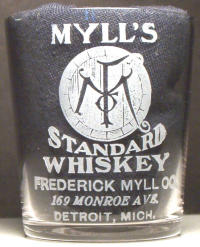
This photo was actually taken indoors using artificial light. It
was taken by Bill Naglik (fathertime15857) to sell a glass
online.
His auctions contain some of the best renditions
of glasses that I've seen online, which why this photo is included
here.
Bill's technique is a variation on the one described on
the first page. In
fact, seeing this photo convinced me that taking good shots
indoors using artificial light was not only possible but
practical. Nice job Bill.
The light source is a
color-corrected spot positioned about 3" above and slightly
to the front of the glass. The color-corrected lamp
substitutes for the blue filter described on the first page.
It's a more convenient alternative but also more expensive. The glass is sitting on a piece of
pale-colored computer equipment and the camera lens looks to be about on a level with
the base of the glass.
Reflections:
Most of the reflections that cause problems when
photographing a glass are bouncing off its far side. The
curvature and angle of the glass act to concentrate and funnel
them directly toward the camera lens, much as a satellite dish
concentrates and focuses radio signals onto the receiver.
One common way of dispensing with such reflections is to block
them by putting something inside the glass. Thus, many
auction photos show glasses with towels or socks stuffed in
them, or pieces of black construction paper. Occasionally
this paper ends up being shipped with the glass! In this
example, Bill has used a piece of dark soft material with a fine
weave, and there's just enough of it to fill the glass without
overflowing so the
photo is neat and tidy.
Background:
Stuffing the glass to eliminate
reflections has the additional benefit of solving the issue of
transparency, but the glass is photographed against a dark
background and hence is clean.
Contrast: The dark filler and frontal
lighting ensure that the label is sharply defined. The
fact that the glass is sitting on a light-colored surface
helps because it reflects light upward and onto the label.
While a light colored surface is not required for clear
rendition of the label, it does have the advantage of lightening
the overall feel of the photo and relieves the gloom
of a black background.